
Neoclassicism, also spelled Neo-classicism, emerged as a Western cultural movement in the decorative and visual arts, literature, theatre, music, and architecture that drew inspiration from the art and culture of classical antiquity. Neoclassicism was born in Rome, largely due to the writings of Johann Joachim Winckelmann during the rediscovery of Pompeii and Herculaneum. Its popularity expanded throughout Europe as a generation of European art students finished their Grand Tour and returned from Italy to their home countries with newly rediscovered Greco-Roman ideals. The main Neoclassical movement coincided with the 18th-century Age of Enlightenment, and continued into the early 19th century, eventually competing with Romanticism. In architecture, the style endured throughout the 19th, 20th, and into the 21st century.

Jean-Henri Riesener was a famous German ébéniste (cabinetmaker), working in Paris, whose work exemplified the early neoclassical "Louis XVI style".

The Bureau du Roi, also known as Louis XV's roll-top desk, is the richly ornamented royal cylinder desk which was constructed at the end of Louis XV's reign, and is now again in the Palace of Versailles.

Ormolu is the gilding technique of applying finely ground, high-carat gold–mercury amalgam to an object of bronze, and objects finished in this way. The mercury is driven off in a kiln, leaving behind a gold coating. The French refer to this technique as "bronze doré"; in English, it is known as "gilt bronze". Around 1830, legislation in France outlawed the use of mercury for health reasons, though use continued to the 1900s.

The Empire style is an early-nineteenth-century design movement in architecture, furniture, other decorative arts, and the visual arts, representing the second phase of Neoclassicism. It flourished between 1800 and 1815 during the Consulate and the First French Empire periods, although its life span lasted until the late-1820s. From France it spread into much of Europe and the United States.
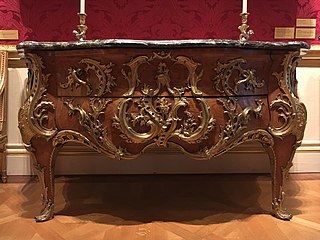
Jacques Caffieri was a French sculptor, working for the most part in bronze.
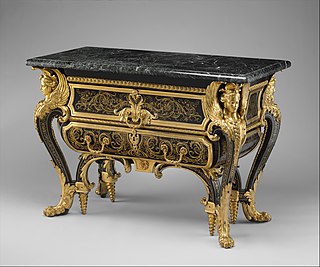
André-Charles Boulle, le joailler du meuble, became the most famous French cabinetmaker and the preeminent artist in the field of marquetry, also known as "inlay". Boulle was "the most remarkable of all French cabinetmakers". Jean-Baptiste Colbert recommended him to Louis XIV of France, the "Sun King", as "the most skilled craftsman in his profession". Over the centuries since his death, his name and that of his family has become associated with the art he perfected, the inlay of tortoiseshell, brass and pewter into ebony. It has become known as Boulle work, and the École Boulle, a college of fine arts and crafts and applied arts in Paris, continues today to bear testimony to his enduring art, the art of inlay.

Antoine-Robert Gaudreau was a Parisian ébéniste who was appointed Ébéniste du Roi and was the principal supplier of furniture for the royal châteaux during the early years of Louis XV's reign. He is largely known through the copious documentation of the Garde-Meuble de la Couronne; he entered the service of the Garde-Meuble in 1726. However, since his career was spent before the practice of stamping Paris-made furniture began (1751), no stamped piece by Gaudreau exists and few identifications have been made, with the exception of royal pieces that were so ambitious and distinctive that they can be recognized from their meticulous inventory descriptions.

Louis-Simon Boizot (1743–1809) was a French sculptor whose models for biscuit figures for Sèvres porcelain are better-known than his large-scale sculptures.
Gilles Joubert (1689–1775) was a Parisian ébéniste who worked for the Garde-Meuble of Louis XV for two and a half decades, beginning in 1748, earning the title ébéniste ordinaire du Garde-Meuble in 1758, and finally that of ébéniste du roi on the death of Jean-François Oeben in 1763. He produced case furniture in a robust Rococo style, ranging from simple veneered bidets to grand commodes that integrated gilt-bronze mounts into the forms of furniture with subtle three-dimensional curves (bombé). From the later 1760s his furniture increasingly shows a conservative compromise with the nascent neoclassical style.
The Menus-Plaisirs du Roi was, in the organisation of the French royal household under the Ancien Régime, the department of the Maison du Roi responsible for the "lesser pleasures of the King", which meant in practice that it was in charge of all the preparations for ceremonies, events and festivities, down to the last detail of design and order.

Pierre-Philippe Thomire (1751–1843) a French sculptor, was the most prominent bronzier, or producer of ornamental patinated and gilt-bronze objects and furniture mounts of the First French Empire. His fashionable neoclassical and Empire style furnishing bronzes established the highest standard in refined finish in the craft that the French called that of the fondeur-ciseleur, "founder-finisher". In his pre-Revolutionary training, Thomire appeared first as a ciseleur, in the division of duties that went into the production, for example, of a set of gilt-bronze wall-lights delivered for Marie-Antoinette's card-room, her Salon des Jeux at Compiègne: under the general supervision of Hauré, the wax and wooden model was carved by Martin, cast by Forestier, and chased by Thomire, as Pierre Verlet was able to show over fifty years ago.

The Hôtel de la Marine, also known (formerly) as the Hôtel du Garde-Meuble, is an historic building on the Place de la Concorde in Paris, just east of Rue Royale. It was designed by the architect Ange-Jacques Gabriel and built between 1757 and 1774 on the newly created square first called Place Louis XV. The identical building across the street, constructed at the same time, now houses the Hôtel de Crillon and the Automobile Club of France.
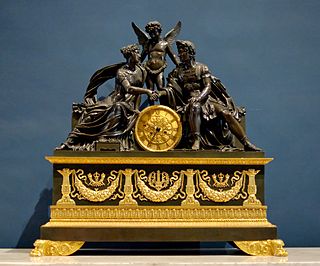
A French Empire-style mantel clock is a type of elaborately decorated mantel clock that was made in France during the Napoleonic Empire (1804–1814/15). Timekeepers manufacturing during the Bourbon Restoration (1814/1815–1830) are also included within this art movement as they share similar subjects, decorative elements, shapes, and style.
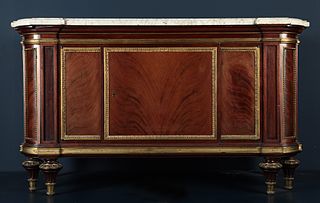
Guillaume Beneman or Benneman was a prominent Parisian ébéniste, one of several of German extraction, working in the early neoclassical Louis XVI style, which was already fully developed when he arrived in Paris. Beneman arrived in Paris already trained; he was settled in the rue du Faubourg Saint-Antoine when he was received master in 1785 by royal command. He rapidly became the last of the royal cabinet-makers before the French Revolution, working under the direction of the sculptor-entrepreneur Jean Hauré, fournisseur de la cour.

Bernard II van Risamburgh, sometimes Risen Burgh was a Parisian ébéniste of Dutch and French extraction, one of the outstanding cabinetmakers working in the Rococo style. "Bernard II's furniture is brilliant in almost every respect. His carcasses are beautifully shaped, his mounts and marquetry are always in complete balance even when extremely elaborate, and there is a logic to his works that allows the eye to comprehend them effortlessly," wrote Ted Dell.

Jean-Pierre Latz was one of the handful of truly outstanding cabinetmakers (ébénistes) working in Paris in the mid-18th century. Like several of his peers in the French capital, he was of German origin. His furniture is in a fully developed rococo style, employing boldly sculptural gilt-bronze mounts complementing marquetry motifs of flowers and leafy sprays, in figured tropical veneers like tulipwood, amarante, purpleheart and rosewood, often featuring the distinctive end-grain cuts. He also produced lacquered pieces, most famously the slant-front desk in the collection of Stavros Niarchos, Paris.

Pierre Macret (1727–1806) was a well-known Parisian cabinetmaker (ébéniste). At the death of the widow of Jean-Pierre Latz in December 1756, he received Latz' court warrant as marchand-ébéniste privilégié du Roi suivant la Cour,, a brevet that exempted him from the stringent regulations of the Paris guild. In 1758 he was belatedly admitted maître-ébéniste by the guild, which henceforth required him to stamp his production. Numerous pieces bearing Macret's poinçon survive.

François Rémond was a French master metalworker and bronze gilder who achieved renown in his day, and whose work is still greatly valued. It included stand-alone works such as candelabras, the decorative casings for clocks and bronze ornamentation for the elaborate furniture made for the elite at the time.
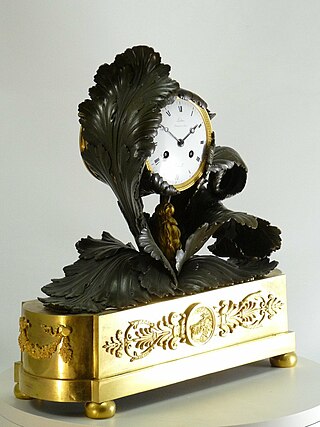
Pierre-Victor Ledure, (1783–1840?) was a French marchand-fabricant (merchant-manufacturer) of bronzes, specialising in ormolu clock cases. He often worked together with the clockmaker Claude Hémon (1770–1820), who supplied the clockworks. Ledure's workshop is listed in Paris between 1813 and 1840, first in the Rue Neuve-des-Petits-Champs, then in the Rue Vivienne and finally in the Rue d'Angoulême.
"The Empire clock, like the furniture, adopts a monumentality, a robustness, one can even say a severity, which radically distinguish it from the works of the 18th century. The shapes become simpler, stiffer and, often, heavier."




















